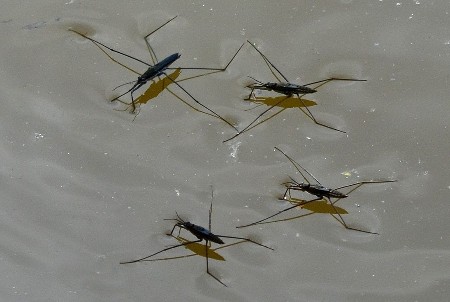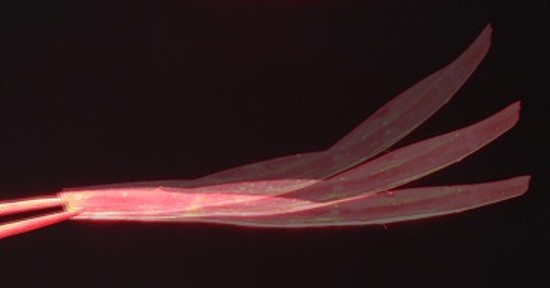“Fueled by water and remotely powered by light” is the description given to this new invention in a research article recently published in the journal, Science Robotics. Entitled, “Light-powered soft steam engines for self-adaptive oscillation and biomimetic swimming,” researchers Zhiwei Li and Yadong Yin from University of California Riverside’s Department of Chemistry, and Nosang Vincent Myung, from University of Notre Dame’s Department of Chemical and Biomolecular Engineering, have invented what they call a Neusbot, a triple-layered film consisting of nanomaterials that in the presence of light convert it into thermomechanical motion.
The name Neusbot comes from the insect group known as Neuston or colloquially called water striders. These small semi-aquatic creatures (see picture below) appear to glide effortlessly over the surfaces of ponds, lakes and streams. They achieve this using leg motion to move across water surfaces without ever sinking.

A Neusbot may not be built like a water strider but it sits astride the water. It bears no resemblance to the insect but rather has the appearance of a piece of film that when laid on a water surface can do magical things. Consisting of three layers, a fourth layer is in the works, the Neusbot absorbs water from below and sunlight from above, and converts the light to heat which changes the water from a liquid to a steam state. The steam provides the locomotion. That’s why Li, the lead author of the article mentioned above, describes the Neusbot as a “tri-layer film that behaves like a steam engine.”
How does it work? The three layers are made of different materials and are all salt-tolerant so deployment in ocean water is not a problem. The top layer absorbs light. The middle layer composed of iron oxide and copper nanorods converts light to heat which vaporizes liquid water turning it into steam bubbles that produce thermomechanical locomotion. The hydrophobic bottom layer which repels water acts similar to the legs of the water strider allowing for oscillations to the entire structure which then linearly moves across a water surface without sinking.
The aforementioned fourth layer has yet to be added but it would be designed to do the work of clean-up which could vary depending on the job requirement. A four-layer Neusbot could:
- clean up surface oil spills
- remove toxic chemicals from water surfaces
- decontaminate drinking water sources
States Li, “Our motivation was to make soft robots sustainable and able to adapt on their own to changes in the environment. If sunlight is used for power, this machine is sustainable, and won’t require additional energy sources.”
That means when deployed the Neusbot will work on its own indefinitely as sunlight provides the energy to push it along. Li and his associates believe a second directed light source would allow the Neusbot to do far more complex moves.
When compared to current technology used for cleaning up marine oil spills, Neusbot would be a gamechanger. That’s because surface oil spills today require ships equipped with skimmers, booms, and vacuums to suck up the oil. Often the oil on the surface is burned off when there is far too large a spill for the equipment to contain and remove. In addition, the turbulence of ocean surface waters can cause a significant percentage of the oil to sink below the surface where it cannot be captured.
Deploying a Neusbot would be far less intrusive. Even in rough seas, it would just float back to the surface each time it is struck by a wave. and continue working until the job is finished. And once done, the Neusbot is completely reusable. That’s not often the case with current equipment and materials used to soak up oil spills.
















[…] Soft Robots Powered by Light May Clean Up Future Oil Spills and Decontaminate Drinking Water […]